Philips PUS8959, also known by other designations under the abbreviation PUS89 (depending on the retail network), is a model from the popular series The One. Its biggest standout feature is the Ambilight system, which continues to make a great impression. The three-sided backlighting adjusts to the image on the screen, making films, series or games literally extend beyond the edges of the TV. The One is also a good option for gamers. The 120 Hz panel and low input lag make games run smoothly, and the motion on screen is clear. We tested several dynamic titles on the console, and the TV handled them without any issues – no stuttering or delays. Additionally, support for HGiG allows for better rendering of HDR effects in games. This is a great solution if we care about matching the image with what the creators intended. The picture quality is good, particularly during the day. With a brightness level of 550 nits, The One performs well even in well-lit rooms, and Dolby Vision in HDR movies delivers vivid colours and sharp details. However, the ADS panel has its limitations – black in dark scenes more resembles a grey shade, which can be noticeable when watching in a darkened room. When we watched movies with the lights off, the lack of depth in the blacks was somewhat striking. The Titan OS operating system is something that still needs refinement. It’s fast, but the limited number of applications can be frustrating for those used to more extensive platforms like GoogleTV. In daily use of Netflix or YouTube, it works flawlessly, but if we're counting on more advanced features, the system may not meet expectations. Overall, the Philips The One is a good choice in its price range. The Ambilight system impresses and significantly enhances the viewing experience, especially in the evening. It’s also a solid option for gamers, thanks to the smooth image and low input lag. Although the black level isn't perfect, and the operating system needs improvement, the TV excels in everyday use. For fans of unique solutions like Ambilight, this is a proposal that definitely deserves attention.
- Matching (Score)
- Our verdict
- TV appearance
- Where to buy
- Contrast and black detail
- HDR effect quality
- Factory color reproduction
- Color reproduction after calibration
- Smoothness of tonal transitions
- Image scaling and smoothness of tonal transitions
- Blur and motion smoothness
- Console compatibility and gaming features
- Input lag
- Compatibility with PC
- Viewing angles
- TV efficiency during daytime
- Details about the matrix
- TV features
- Apps
- Playing files from USB
- Sound
Philips The One (PUS8959 / PUS8919 / PUS8909 / PUS8949 vs TCL C6K
Direct compare
PUS8959 / PUS8919 / The One / PUS8909 / PUS8949
C6K / C69K / Q6C


Panel type: LCD IPS
Resolution: 3840x2160
System: Titan OS
Model year: 2024
Complete the survey to find out the result

Panel type: LCD VA
Resolution: 3840x2160
System: Google TV
Model year: 2025
Complete the survey to find out the result

Overall rating
6.8
7.1
Movies and series in UHD quality
6.6
6.7
Classic TV, YouTube
6.3
6.6
Sports broadcasts (TV and apps)
7.2
6.3
Gaming on console
8.5
8.4
TV as a computer monitor
8.0
8.6
Watching in bright light
6.1
6.4
Utility functions
6.0
7.0
Apps
6.2
9.6
Sound quality
6.4
6.5
Complete the survey to find out what fits your preferences
Advantages
Ambilight System: Three-sided backlighting
120Hz Panel - smooth image
Extra features for gamers
Satisfactory brightness level that works well during the day
Wide viewing angles
Very good contrast and black levels: VA panel and MINI-LED backlighting
Good motion smoothness: High refresh rate of 144Hz
Decent panel brightness
Many features for gamers: VRR, ALLM, HDMI 2.1, HGiG
Additional mode for PC gamers: 240Hz
GoogleTV system with a wide selection of apps
Support for multiple HDR formats including Dolby Vision
Support for Dolby Atmos and DTS
Very attractive price
Disadvantages
Poor black quality
Annoying "hybrid" remote
Titan OS: Still in development, with a limited number of apps and not very functional compared to more advanced platforms
Management of the backlighting could be better
Language errors in the system
Our verdict
TCL C6K is a TV for those who want to combine gaming and watching movies with good contrast, all without breaking the bank. With its VA panel illuminated by Mini-LED, blacks are deep and contrast is high, making evening viewings look truly impressive. Additionally, it boasts decent brightness, which paired with Dolby Vision gives films a cinematic quality. Importantly, the smoothness of the image – the 144Hz refresh rate works wonders for sports and dynamic games, and gamers receive a full package of bonuses: VRR, ALLM, HDMI 2.1, HGiG, and even a 240Hz mode in PC. For daily use, the TV is powered by Google TV, which offers a multitude of apps and the Gemini AI voice assistant, making navigation convenient and flexible. It's also worth mentioning the sound – support for Dolby Atmos and DTS gives the impression that the device is ready not just for gaming. As is often the case, there are a few things that could be improved. The backlighting in challenging scenes can lose details or wash out blacks, and the Polish translations in the menu can be so clumsy that you really have to think about what’s being said. Despite this, the overall package holds up very well, and considering the price, the TCL C6K could be one of the more interesting choices for anyone looking for a versatile TV for movies, sports, and gaming. Especially when a good promotion comes along – and when TCL traditionally fine-tunes the details in updates.
TV appearance




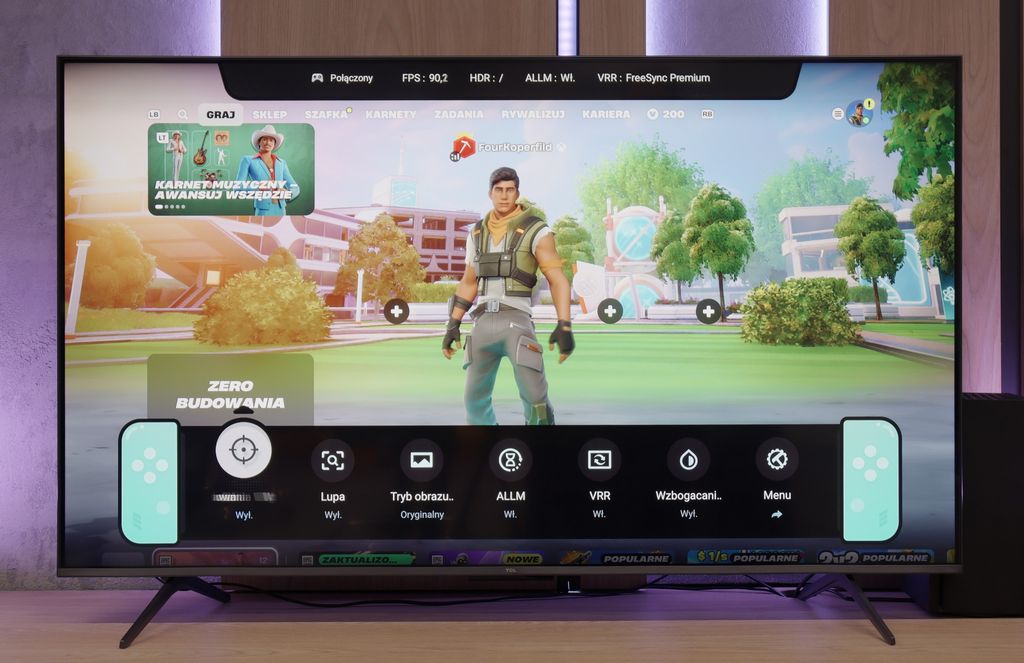
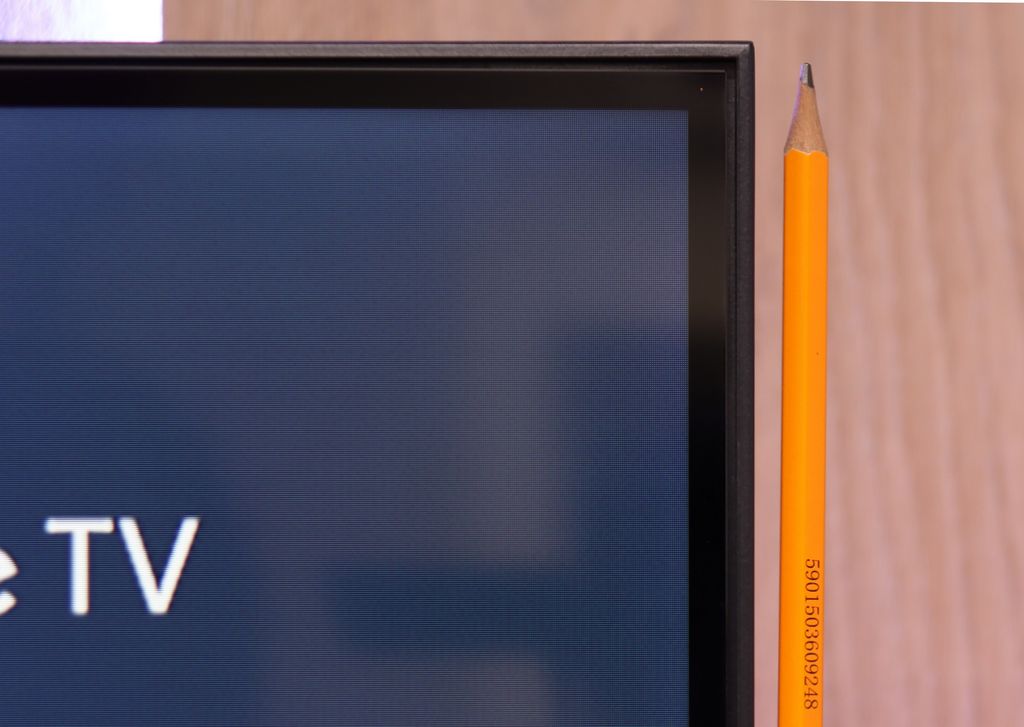
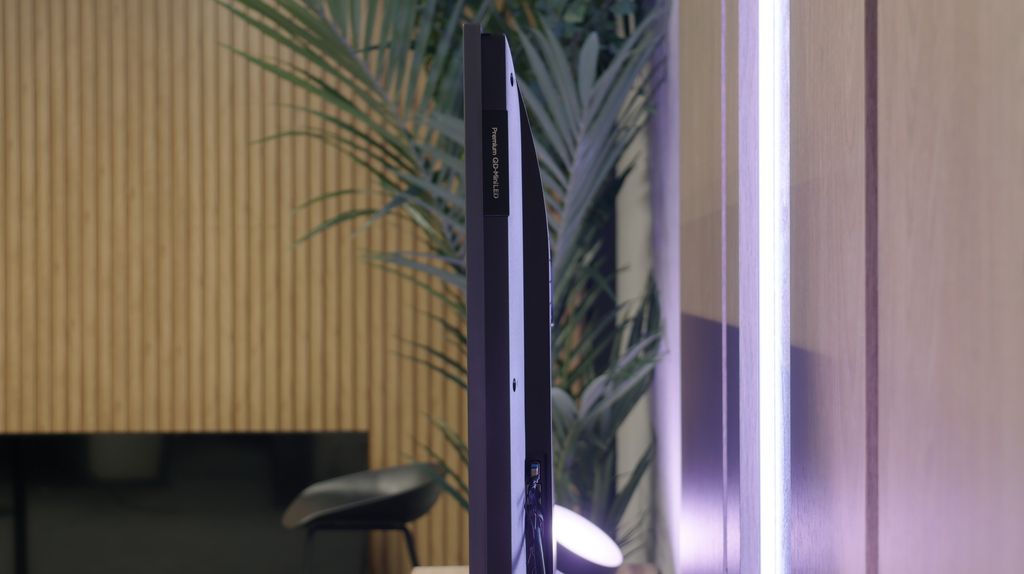
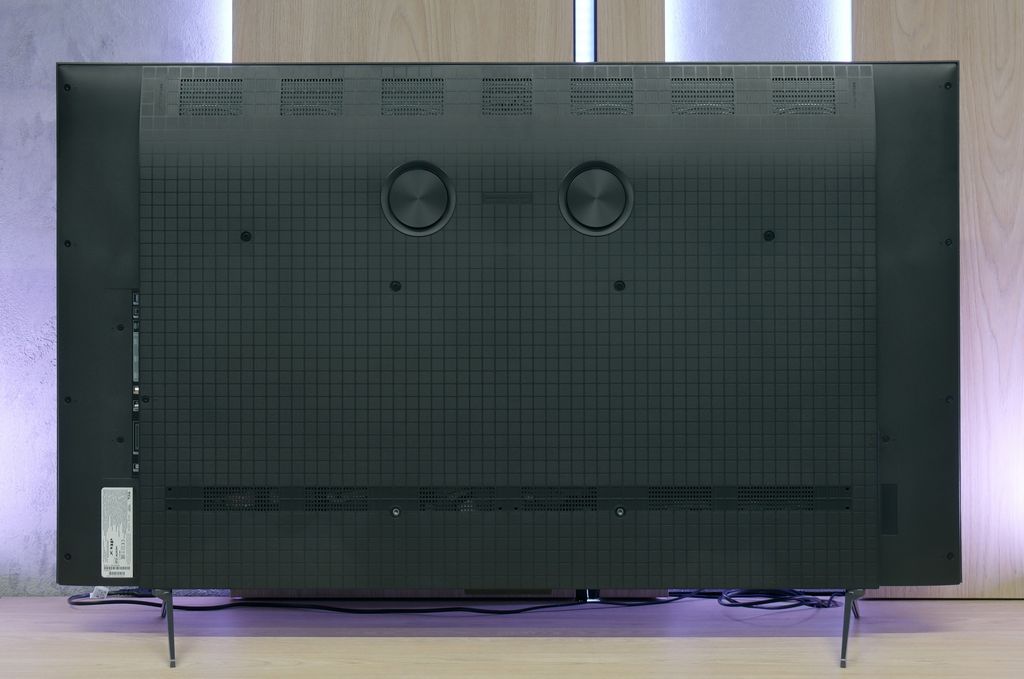
Contrast and black detail
4.3/10
7.3/10
Local dimming function: No
Local dimming function: Yes, number of zones: 180 (10 x 18)
Contrast:

Result
2,350:1

Result
2,400:1

Result
2,600:1

Result
2,550:1

Result
2,200:1

Result
114,000:1

Result
17,300:1

Result
16,200:1

Result
9,900:1

Result
4,850:1
Halo effect and black detail visibility:

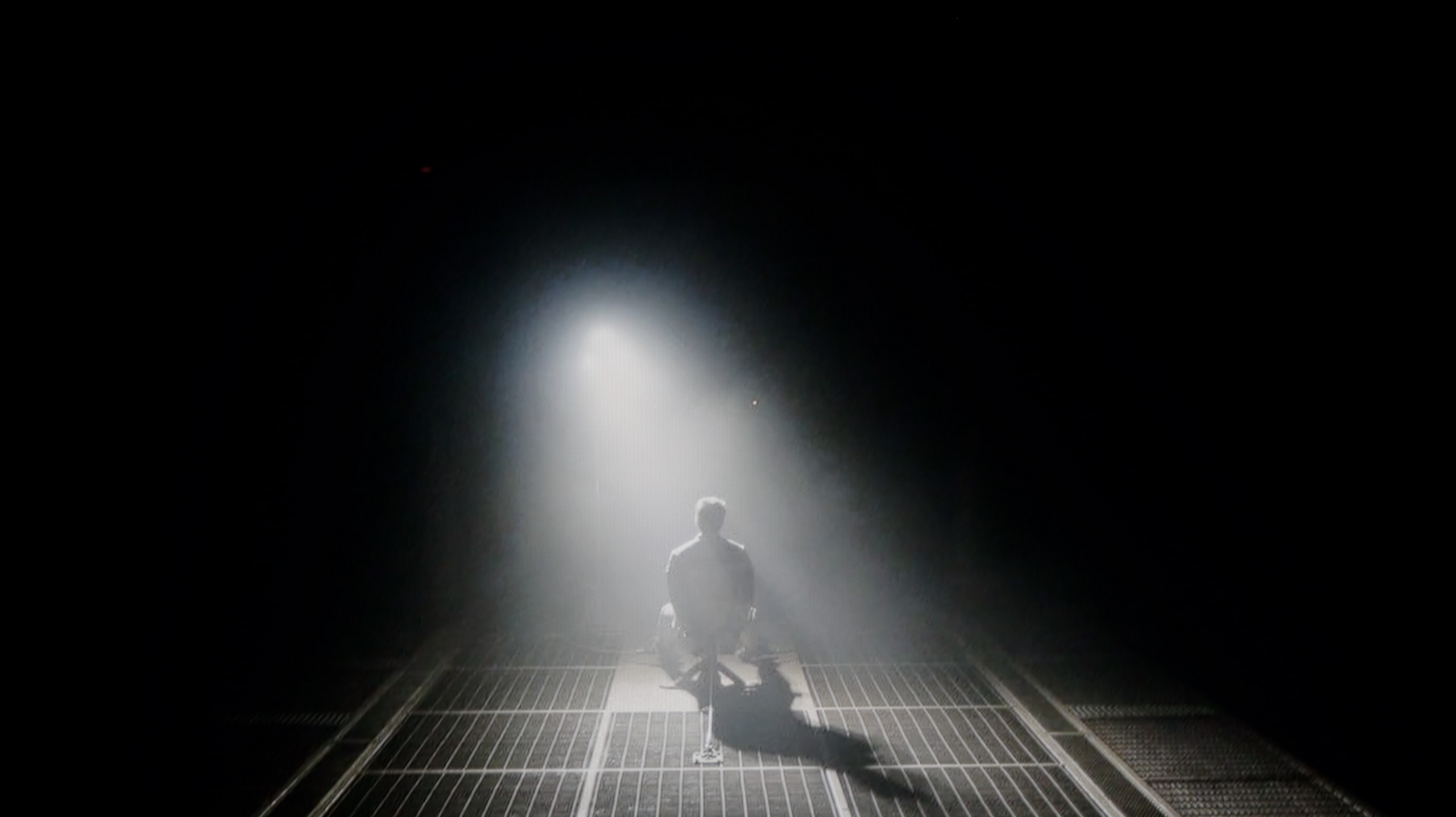
The television Philips PUS8959 is based on an ADS panel, which offers slightly different parameters compared to the popular VA panels. In the tested screens, the contrast was around 2000:1, making the black level far from ideal. ADS panels are known for their weaker contrast compared to VA panels, which in practice means that instead of deep black, we see more navy or grey shades. However, the ADS panel is still better than the standard IPS panel, which cannot achieve such a level of contrast. Additionally, the Philips PUS8959 is not equipped with local dimming technology, which could improve these parameters. The absence of this function exacerbates the effect of shallow blacks, particularly noticeable in dark scenes, such as those in the movie "Sicario 2". Instead of intense black, the screen generates a silvery glow, which can be bothersome, especially when watching in darker conditions. All of this leads to a visual experience that lacks depth, and details in dark scenes are not as well visible as one might expect from higher-end screens. Despite the lack of local dimming, the television is equipped with what is known as Global Dimming. The television is capable of completely dimming the panel to achieve higher contrast, but at the cost of details that may blend together, for example, lights in the test screen from the movie Oblivion. It’s worth noting that the model we received for testing has quite noticeable blobs resulting from uneven backlighting, although this isn't a dealbreaker; one should consider when purchasing that we might receive a similar piece.
The TCL C6K is based on a VA panel, specifically an HVA produced by TCL CSOT, which already delivers a solid native contrast of 6000–7000:1 without the use of local dimming. However, the true strength of this model lies in its Mini-LED backlighting with the ability to dim individual zones. In the tested 55-inch version, we counted around 180 zones, and as the diagonal size increases, this number naturally grows. For a television in this price segment, the contrast is truly impressive. In simpler film scenes, such as segments from 'Oblivion', it looks fantastic, and shots completely filled with black make a great impression. Of course, due to the characteristics of Mini-LED technology, it's not always possible to avoid issues – in more challenging frames with many bright details, halo effects can appear, or some elements may be dimmed too strongly (regardless of local dimming settings). Nevertheless, the contrast can be regarded as a strong point of the C6K.
HDR effect quality
5.9/10
4.9/10
Luminance measurements in HDR:

Result
501 nit

Result
514 nit

Result
553 nit

Result
544 nit

Result
569 nit

Result
612 nit

Result
202 nit

Result
424 nit

Result
144 nit

Result
587 nit
Scene from the movie “Pan” (about 2800 nits)


Scene from the movie “Billy Lynn” (about 1100 nits)


Static HDR10


Dynamic: Dolby Vision
Dynamic: Dolby Vision


HDR luminance chart:
TCL C6K
Luminancja HDR
Luminance of RGB colors
Philips The One (PUS8959 / PUS8919 / PUS8909 / PUS8949
Luminancja HDR
Luminance of RGB colors
The luminance graph for Philips PUS8959 shows that the television can achieve around 550 nits of brightness, which can be considered a satisfactory level. Such brightness allows you to feel the effects of HDR, which stand out particularly in more demanding scenes. In the tested patterns, the television performed quite well, even in challenging sequences like those from "Sicario 2". Due to the lack of local dimming, the television does not dim small bright elements, and they shine at the full "power" of the television but at the cost of silvery blacks, which we mentioned in the paragraph about black levels. It’s also worth praising Philips PUS8959 for its good coverage of the DCI-P3 colour palette, which is around 94.5%. This ensures that the colours are vivid and close to the creators' intentions, which further enhances the quality of HDR effects and the experience of watching high dynamic range content.
TCL C6K is a moderately bright television that can showcase its full capabilities in the best movie conditions – the maximum brightness is around 600 nits. In scenes with large, intense light sources, the HDR effect can be truly satisfying, providing a sense of cinematic sparkle. However, it's important to remember that with local dimming management, there are situations where some elements become dimmed, and sometimes even barely visible. It is clear that there is a lack of proper optimization of the algorithms, although looking at the technical parameters in this price range, the build quality performs very well.
Factory color reproduction
4.1/10
5/10


Factory Mode
After calibration


Factory Mode
After calibration
The television Philips PUS8959 has been tested in the best, theoretically most precise picture mode – Filmmaker. Although the name suggests film quality, it unfortunately falls short of perfection. The biggest issue in this mode is the white balance, both in HD and 4K content. It is characterised by a significant dominance of the red colour and drops in the green levels, resulting in unnatural colour reproduction. For example, white elements of the image have a noticeable pink hue, and the green is less intense, which diminishes the overall naturalness and colour balance. The ColorChecker test confirms these errors – it is clearly visible how the colour samples "deviate" from the proper values, which can best be observed on the sample squares that should precisely reproduce the colours. The lack of accuracy in this regard affects the realism and fidelity of the image, which is particularly undesirable in Filmmaker mode.
As for the brightness characteristics, the gamma graph resembles a roller coaster – with small elements displayed on the screen, the brightness is excessive, causing details to become overly exposed. Conversely, at higher gamma values, the image loses contrast and becomes too dark, making the whole appear lacking in dynamism. Similar problems can be observed in the EOTF characteristics – the television is unable to accurately reproduce the brightness levels, negatively impacting the overall picture quality.
This year's TCL televisions have introduced the Filmmaker mode, and it must be said that it is definitely the best choice right out of the box. This is the mode we recommend for everyday viewing of movies and series. Unfortunately, as is often the case, the best does not mean perfect. In the case of SDR content, the image was too warm, as the red was quite prominent in the white balance. On the other hand, with HDR content, we had the opposite impression – the image became cooler than it should have been, due to an excess of blue. There is also the brightness characteristic, which at times led to overexposure. In practice, these issues combined resulted in quite noticeable errors in colour tests, which are hard to accept in a mode advertised as “by the creators”.
Color reproduction after calibration
8.1/10
7.5/10

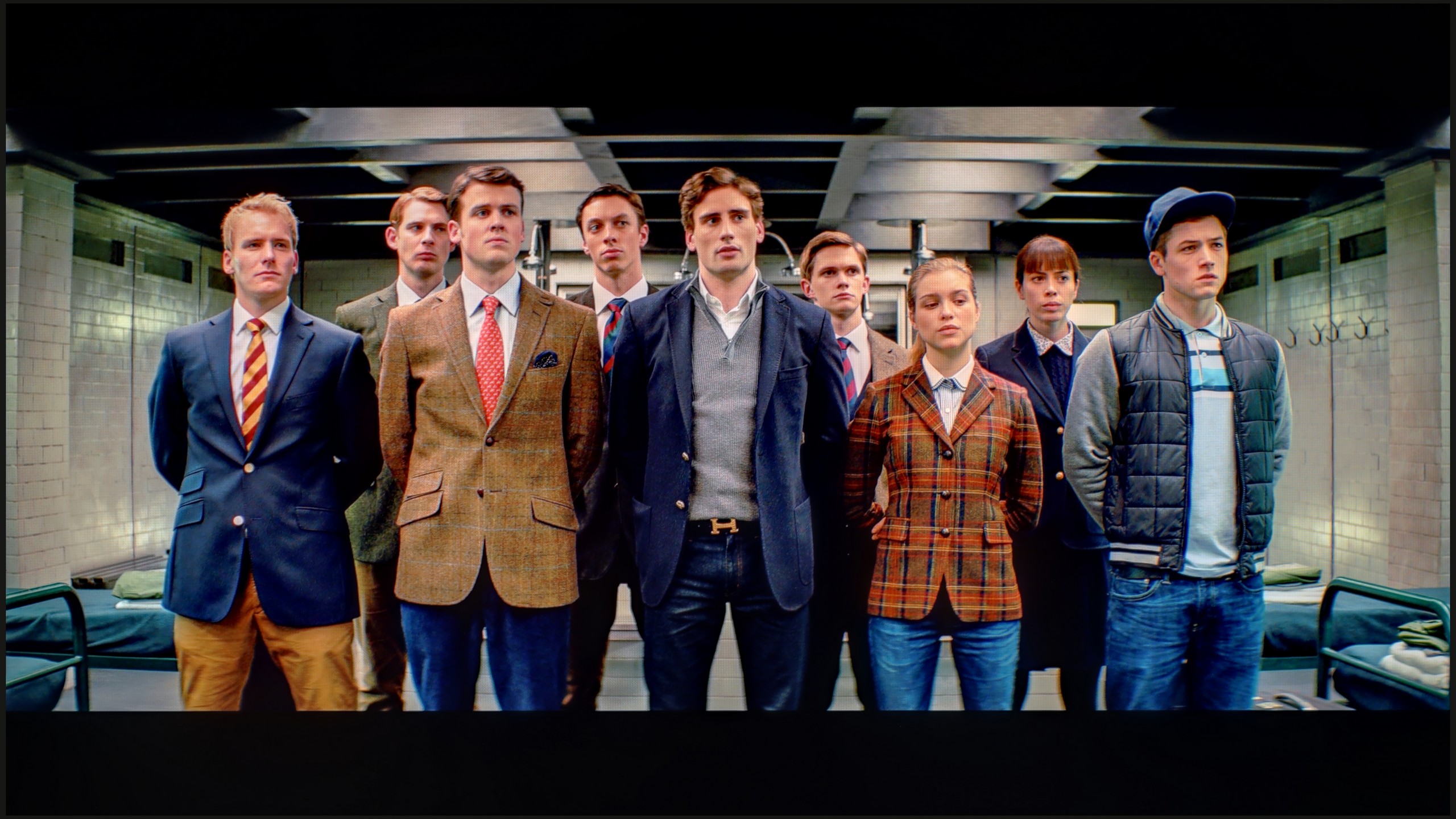


After calibration, the Philips PUS8959 shows a significant improvement in colour reproduction, especially in HD content. The white balance is exceptionally even, and the Delta E error values are below 1, which can be regarded as an outstanding result. Additionally, the gamma, which affects brightness in lower quality materials, performs very well, maintaining a stable level at 2.4, leading to an appropriate balance between bright and dark areas of the image.
When it comes to 4K HDR materials, there is also a noticeable improvement. The white balance, although not as perfect as in HD content, no longer suffers from excessive red exposure, making the image appear more natural and harmonious. Unfortunately, regarding the EOTF characteristic, it’s difficult to speak of any significant improvement, which stems from the structural limitations of the television that prevent substantial enhancement in this aspect.
Nevertheless, overall, it looks much better after calibration, making the Philips PUS8959 one of those televisions where it's truly worth investing time in precise calibration to achieve satisfactory image quality.
Thanks to the white balance adjustment, we were able to significantly reduce the C6K's tendency to distort colours, which resulted in a very good end result. After calibration, we won't observe the effect of excessive warming of scenes in SDR or overly cooling the image in HDR. However, it is worth taking a closer look at the brightness characteristics. In SDR content, it's hard to have major objections – the picture looks really good, especially in older movies, TV shows, or material from YouTube. It performs significantly worse with HDR content. An analysis of the EOTF curve suggests that everything is fine, but in practice (EOTF in movies), the limitations of the construction become apparent. The television tends to excessively brighten the smallest fragments of the frame, and in other situations, it can overly dim the entire scene. The effect of calibration is therefore noticeable, and regarding colourimetry, the C6K has really gained a lot, but certain limitations resulting from local dimming and actually from its management by the C6K simply cannot be overlooked.
Smoothness of tonal transitions
8.9/10
9.5/10












The gradation on the Philips PUS8959 television looks very good, offering smooth tonal transitions in most scenes. Occasionally, minor issues can be detected, especially in transitions between certain colours, where subtle inconsistencies are noticeable. However, these imperfections are subtle enough that they do not significantly impact the overall viewing experience and can be considered completely acceptable. In everyday use, the television provides good enough gradation quality to satisfy even more demanding users, maintaining the naturalness of the image and a lack of glaring tonal distortions.
The transitions between colours in the C6K are very smooth, and it’s hard to nitpick any banding. The image looks natural, and any minor imperfections can only be noticed on bright test patterns – and only with really careful viewing. In everyday use, the effect is simply fantastic, and it’s safe to say that in this category, the C6K performs outstandingly.
Image scaling and smoothness of tonal transitions
6.5/10
5/10
Smooth transition function

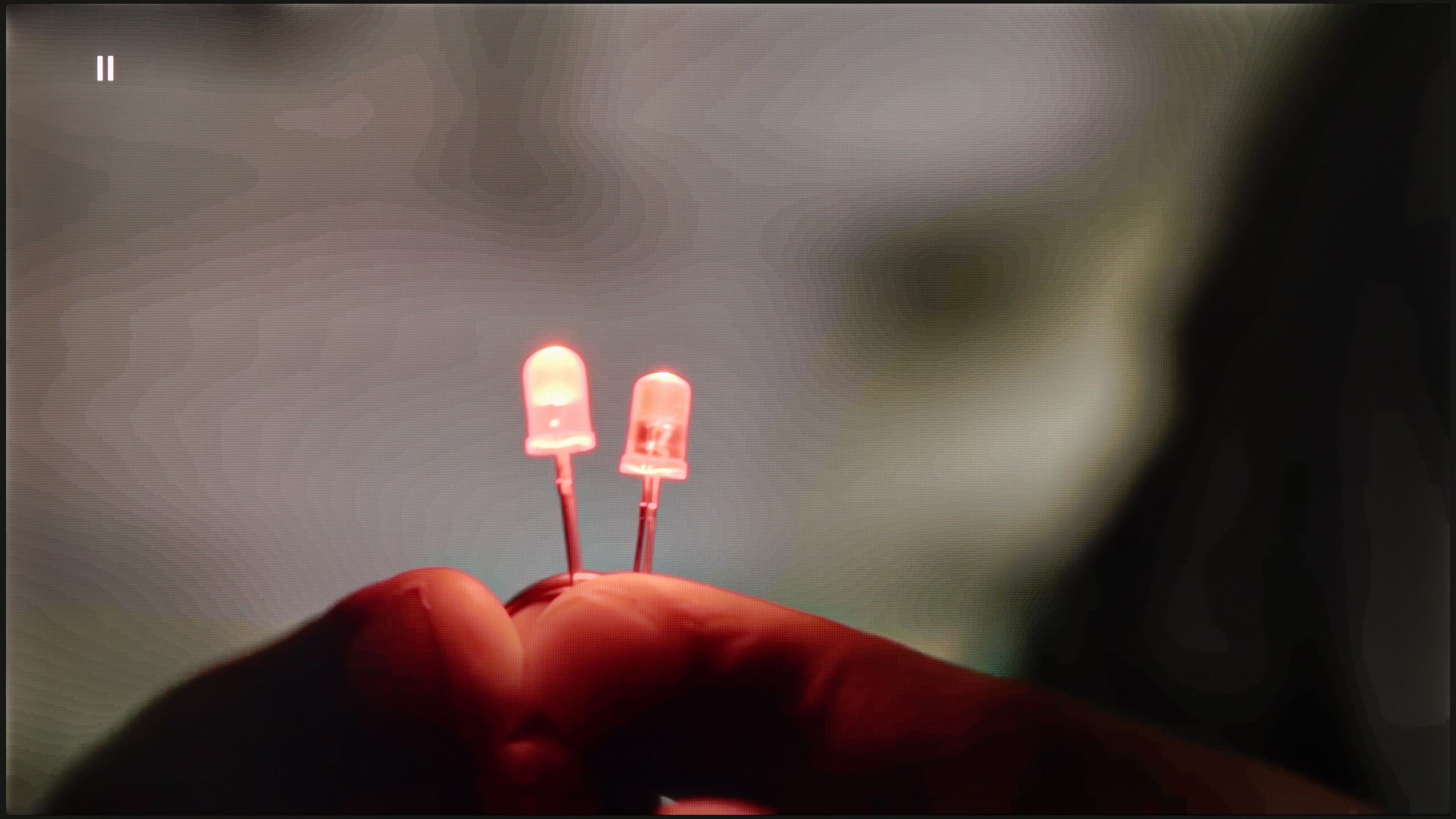
Image without overscan on the SD signal


When it comes to smoothing tonal transitions, the "Distortion Reduction" function in the minimum position performs quite well, effectively smoothing tonal transitions without excessive impact on other elements of the image. In testing, I did not notice that the reduction negatively affected the structure of the image, such as film grain or details of objects – everything remains in its place, which is a big plus for users who value the natural look of film material.
As for digital processing, the image looks pretty good, although it features very softened contours, giving it an almost "leafy" character. This effect may evoke mixed feelings – some users will appreciate the fluidity and delicacy of this type of presentation, while others may find it too gentle, losing detail. It is a matter of individual preference, but it must be admitted that Philips PUS8959 provides quite subtle yet effective tools for improving tonal transitions without excessive interference with the natural character of the image.
TCL C6K performs quite well in terms of upscaling. Lower quality materials appear acceptable, and the absence of overscan issues means the image is displayed in full, without cropping. However, one cannot expect miracles – very low quality content won't come to life here, as the image processor has its limitations. On thin lines or details, there is characteristic tearing visible, which indicates a lack of advanced image enhancement algorithms. It is also a shame that the C6K lacks the function of smoothing tonal transitions – in older films or video materials, colour banding can be noticeable and may be distracting during longer viewing sessions.
Blur and motion smoothness
8/10
7.3/10

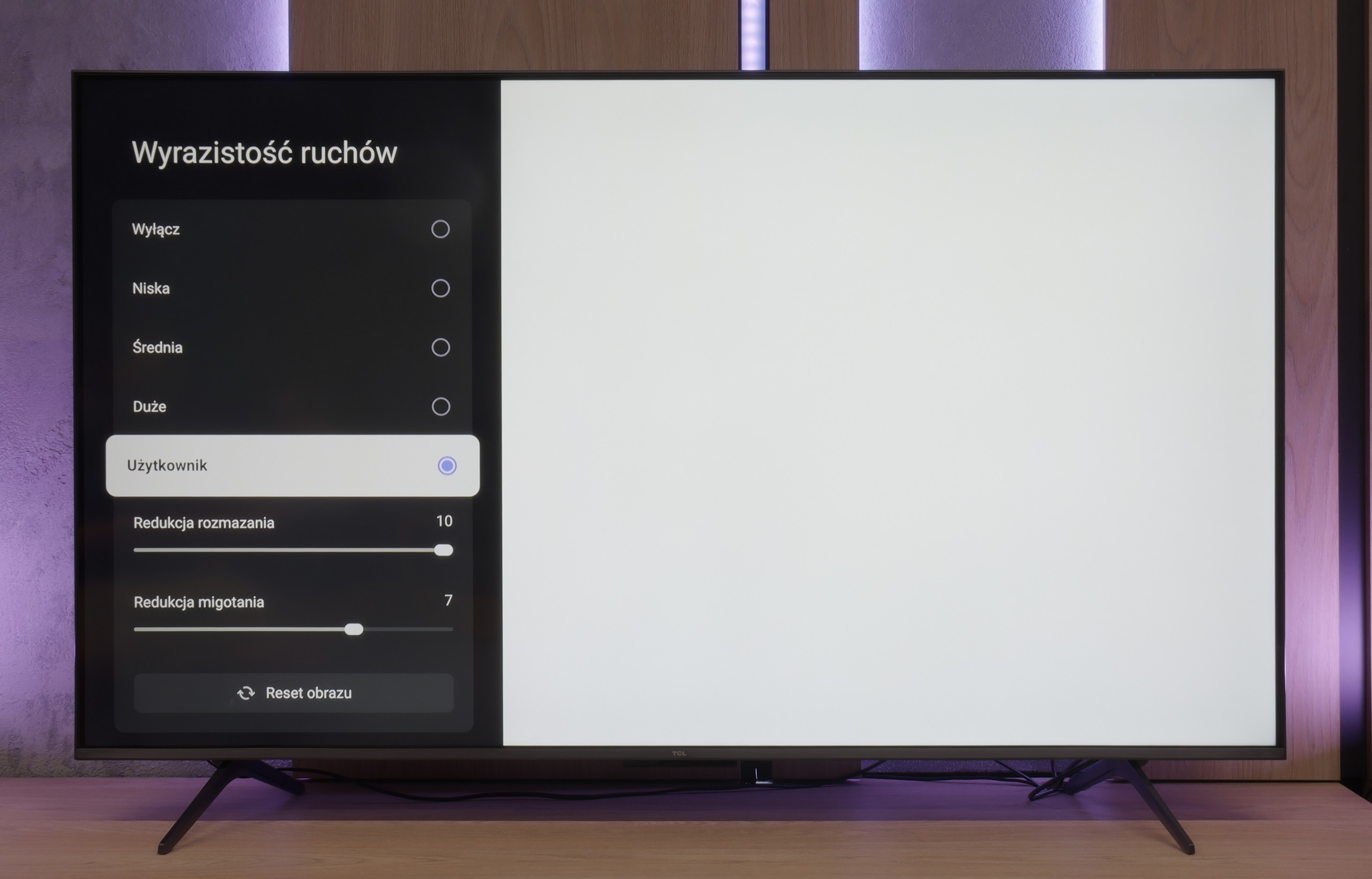
Blur (native resolution, maximum refresh rate):






Blur (BFI function enabled):



Philips PUS8959 TV is equipped with a 120 Hz panel, which should satisfy more demanding users, especially those who love watching dynamic sports broadcasts or playing games. Such a high refresh rate allows for significantly smoother images, being a key aspect during dynamic scenes and fast actions.
For those who prefer watching movies, the TV offers an additional motion smoother that allows adjustment of the frame rate according to personal preferences. The Philips PUS8959 features a 10-step adjustment for functions called "Smoothness" and "Motion Blur Reduction". The "Smoothness" function increases the number of frames through interpolation, making movement on the screen smoother, reminiscent of the so-called "soap opera effect". Meanwhile, "Motion Blur Reduction" focuses on minimising streaking and improving motion clarity, which is particularly noticeable in dynamic sequences such as action scenes or fast sports shots.
TCL C6K uses a 144 Hz panel, which is a significant advantage in this price range. It's an important step forward in comparison to the previous model C655 PRO, which only offered 60 Hz in 4K. The difference is especially noticeable when watching sports or playing games – the ball, players, or fast action in the game are displayed more clearly and without losing detail. An interesting fact is the panel's ability to operate at 240 Hz, which the manufacturer doesn't mention in official materials. We will return to this topic when discussing the PC gaming mode.
TCL has also added a feature for movie watchers: "Motion Clarity," which allows users to adjust the image according to their preferences with two simple sliders. You can either keep the visible film frame or opt for a very smooth, almost theatrical effect. This way, everyone can find settings that match their taste.
Console compatibility and gaming features
9.8/10
9.8/10
- ALLM
- VRR
- VRR range48 - 144Hz48 - 240Hz
- Dolby Vision Game Mode
- Correct implementation of HGIG
- 1080p@120Hz
- 1440p@120Hz
- 4K@120Hz
- Game bar

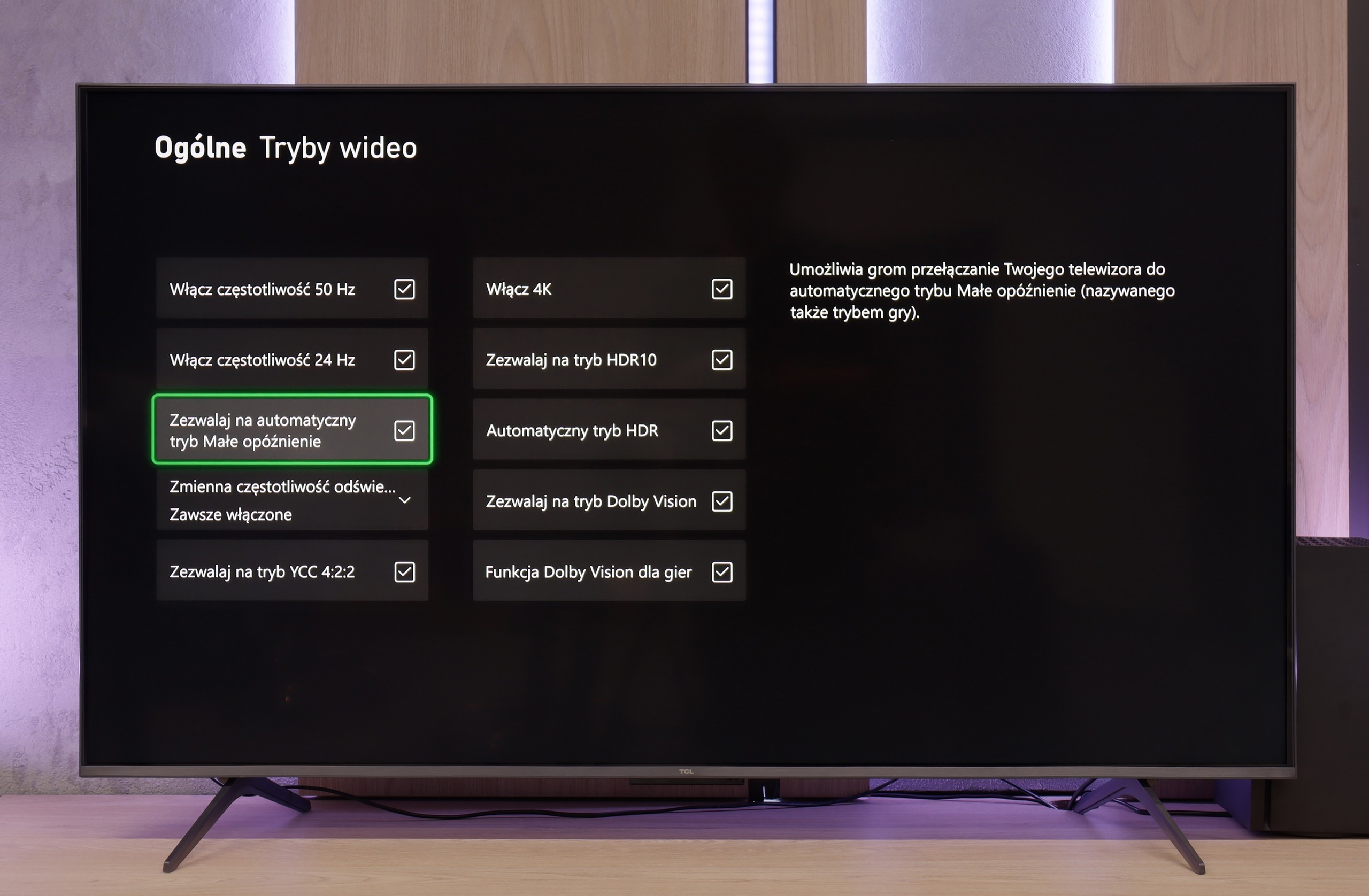

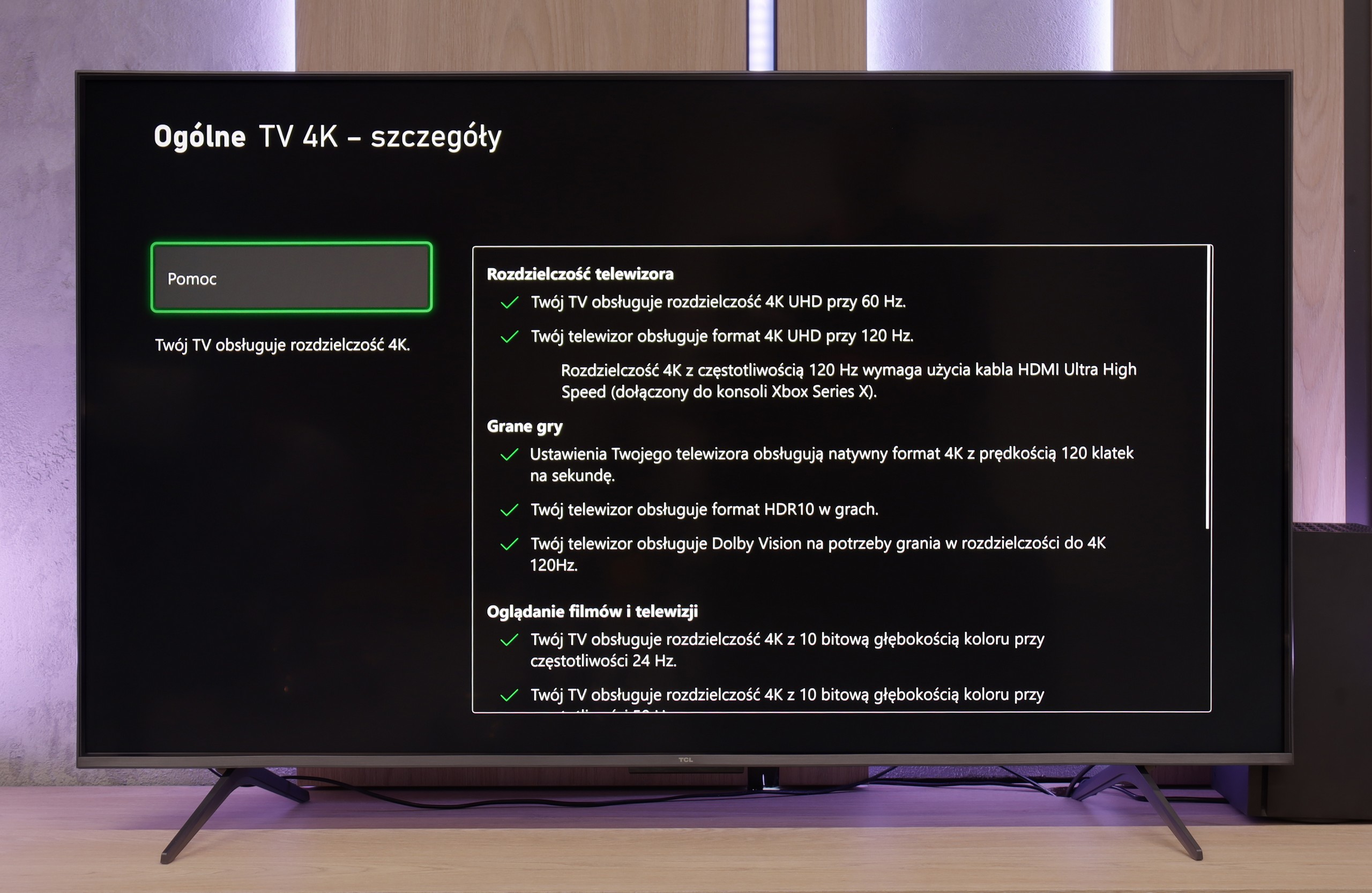

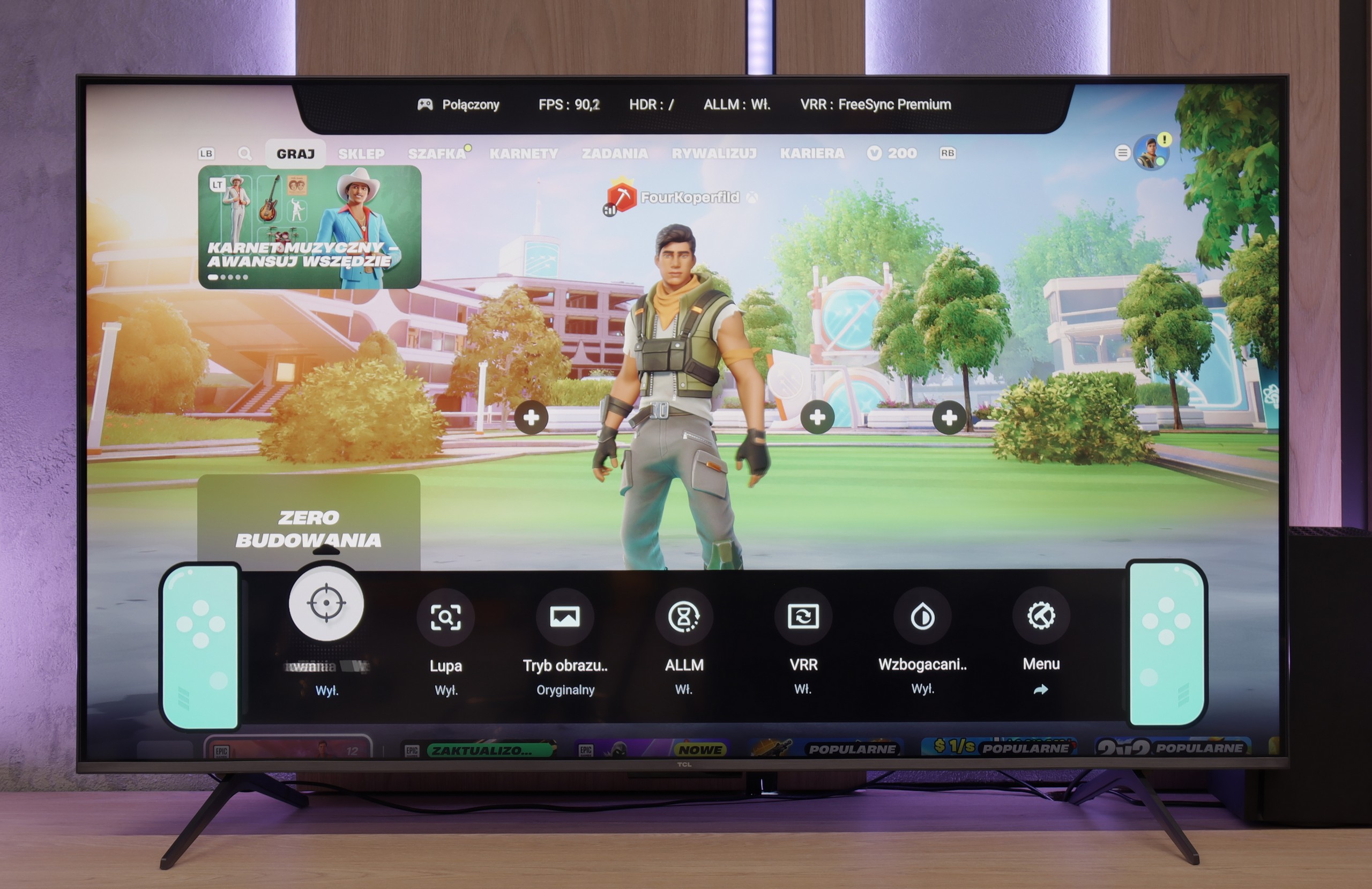


Philips PUS8959 is a television that will surely please gaming enthusiasts. It supports most modern technologies useful during gameplay, such as HGiG, allowing for better representation of HDR effects in games. As a result, the image is more aligned with what the game developers intended to achieve.
The television also supports displaying images at 120 Hz, ensuring smoothness and dynamism, particularly important during action games and sports broadcasts. The Game Bar feature provides quick access to game settings, making it easier to adjust the image according to user preferences without interrupting gameplay.
Unfortunately, the Dolby Vision mode does not offer low input lag, which may be noticeable during dynamic scenes. Nevertheless, thanks to the HGiG feature and high refresh rate, the Philips PUS8959 remains an attractive choice for gamers, offering good image quality and suitable smoothness during gameplay.
The TCL C6K is a television that can confidently be called equipment designed for gamers. We have 4K at 144 Hz, VRR support, an automatic gaming mode (ALLM), and Dolby Vision Gaming. On top of that, there's a practical Game Bar, which is a panel with the most important settings handy – useful when we want to quickly change something during gameplay (e.g. screen ratio: Yes, you can!). Notably, it has a wide range of VRR, reaching up to 240 Hz. However, this option is mainly for PC gamers who drop below the native 4K resolution. In that case, the television can spread its wings and show additional smoothness, especially in fast e-sport titles. For consoles, we stick with the classic limit of 120 Hz, but the possibilities are still quite broad. The only slight drawback is some minor motion blur that can occasionally be seen in dynamic scenes. Other than that, the C6K offers everything gamers expect from a television.
Input lag
9.7/10
9.7/10
SDR
HDR
Dolby Vision
Philips PUS8959 TV offers impressive results in terms of input lag, making it a great choice for gamers. For 120 Hz content, the lag is less than 6 ms, which is an absolutely excellent result and allows for immediate response in games, especially in dynamic titles. For 60 Hz content, the input lag is 15 ms, which is also an outstanding result and ensures comfortable gameplay in most cases.
Unfortunately, the Dolby Vision mode does not perform as well, as the input lag increases to 31 ms. While such a result may be acceptable for less dynamic content, for demanding gamers it may prove insufficient, impacting precision and reaction speed. Nonetheless, in standard modes, Philips PUS8959 still offers remarkable performance, making it a competitive choice in the TV market for gamers.
In terms of input lag, the TCL C6K performs excellently. With 120 Hz content, the delay is around 10 ms, and at times even less. This is at a level where the response is practically instantaneous, and it’s hard to find any complaints. For 60 Hz materials, the result is around 18 ms – still a very good result, more than adequate for comfortable gaming.
Compatibility with PC
8/10
8.6/10

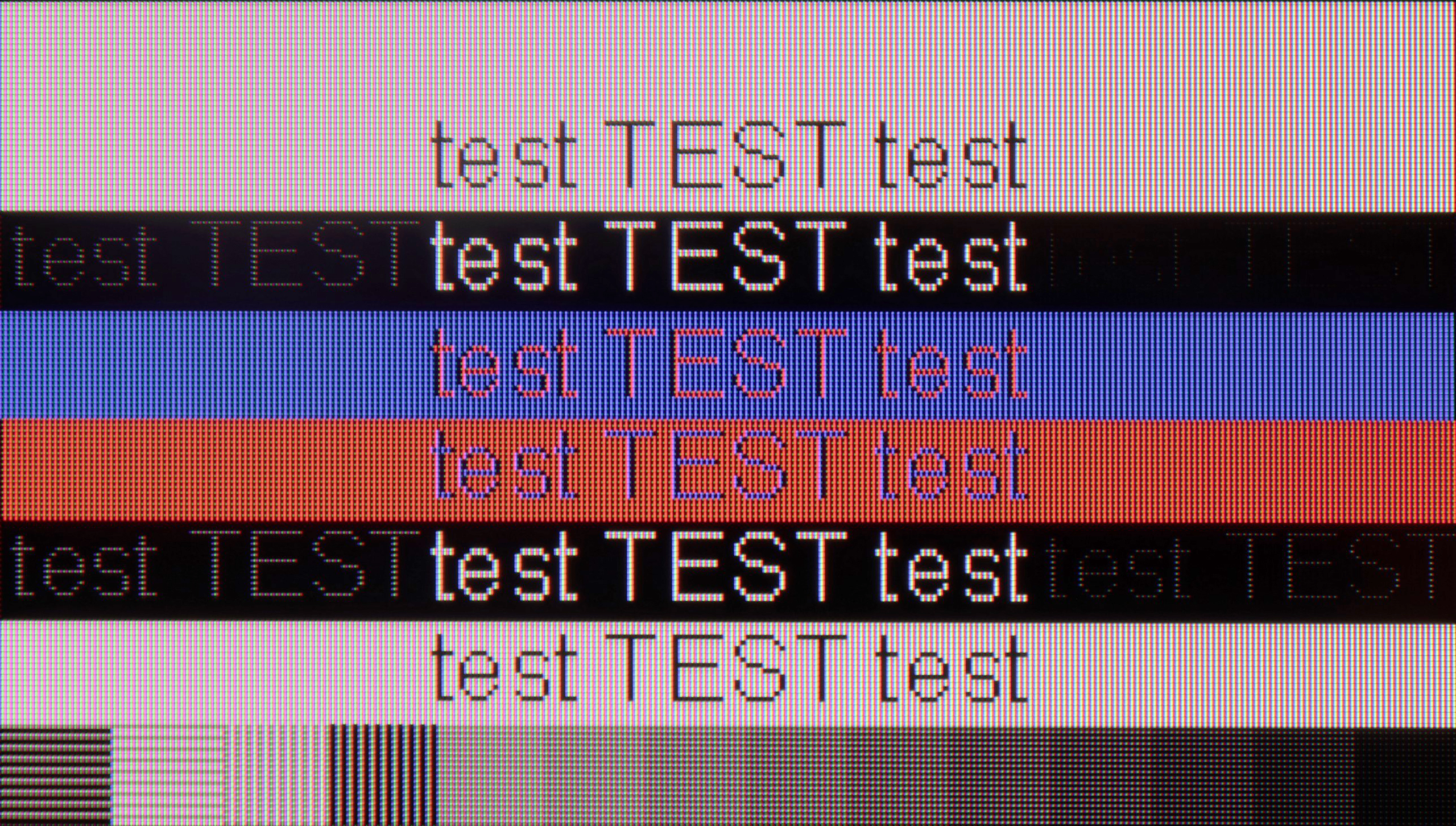
Philips PUS8959 works excellently as a monitor for use with a PC. With support for chroma 4:4:4, it provides full colour clarity, which is crucial for text work – fonts are sharp and readable, regardless of the background they are on. This makes using office applications, browsing the internet, and graphic editing comfortable and precise.
Additionally, the low input lag provided by the television ensures smooth and responsive operation, which is important both during everyday tasks and in more dynamic applications, such as gaming or multimedia editing. Philips PUS8959 is an excellent choice for users looking for a television that also functions as a PC monitor, offering high image quality and user comfort.
After connecting the TCL C6K to the computer, it performs excellently. At native resolution, we have 4K at 144 Hz, and if we lower the resolution, we can even achieve 240 Hz. Additionally, the TV works well with Nvidia and AMD cards – it supports both G-Sync and FreeSync. It’s also hard to fault for office work. Fonts are sharp and readable thanks to 4:4:4 chroma support, and any minor imperfections are so negligible that they're simply not noticeable in regular use.
Viewing angles
6.9/10
3/10
Philips PUS8959, equipped with an ADS panel, offers quite decent viewing angles, definitely better than those found in VA panels. The image retains its quality even when viewing from a wider angle – colours are vivid, and contrast does not deteriorate as much as in VA panel televisions. Because of this, watching the television from different spots in the room still allows for enjoyment of well-saturated colours and overall image quality, which makes Philips PUS8959 perfect for larger rooms and during shared viewing with family or friends.
In the TCL C6K, the viewing angles are typical for VA panels. Sitting directly in front, the picture looks very good, but any movement to the side results in a noticeable drop in colour saturation and brightness. The difference is particularly evident in colourful scenes – the hues become washed out, and the contrast loses its depth. Compared to IPS panels, this is clearly a weaker result, although the better black levels and higher native contrast remain a compensating factor – "you win some, you lose some".
TV efficiency during daytime
6.1/10
6.4/10

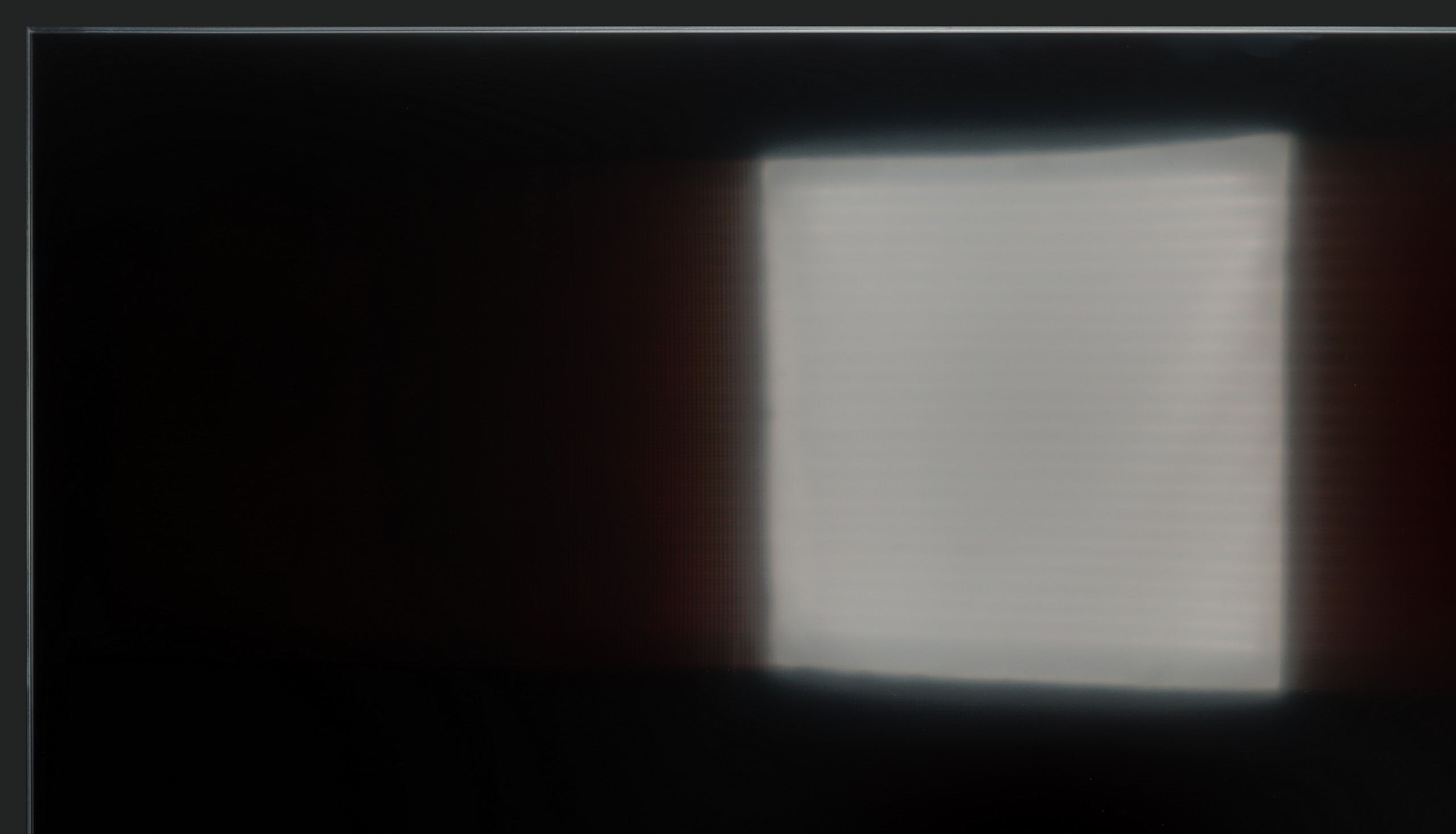


Matrix brightness
Average luminance SDR
TCL C6K: 532 cd/m2
Philips The One (PUS8959 / PUS8919 / PUS8909 / PUS8949: 562 cd/m2
Philips PUS8959 features a satin finish on the panel that effectively dampens light reflections, which is beneficial when using the television in bright daytime conditions. However, such a finish causes blacks to take on shades of grey during the day, losing their depth and intensity, which impacts the perception of the image in darker scenes.
A brightness level of 562 cd/m² allows for comfortable television use during the day, even in well-lit rooms. The image is bright enough to cut through daylight, and the reduction of reflections ensures decent visibility of content, making Philips PUS8959 a good choice for rooms where the lighting level cannot always be controlled.
TCL C6K performs quite well in bright lighting conditions. The panel offers decent brightness – achieving around 550 nits in SDR content, which allows for comfortable viewing in a moderately lit lounge, even on days with strong light coming through the windows. This means that daytime viewing does not require complete darkening of the room. It's also worth noting that the screen coating does quite a good job of reducing reflections, so the TV doesn't turn into a "mirror" even with bright lighting. However, this is not on the level of top models with more advanced anti-reflective coatings – in very challenging conditions, such as large windows, reflections will be noticeable.
Details about the matrix
Subpixel Structure:

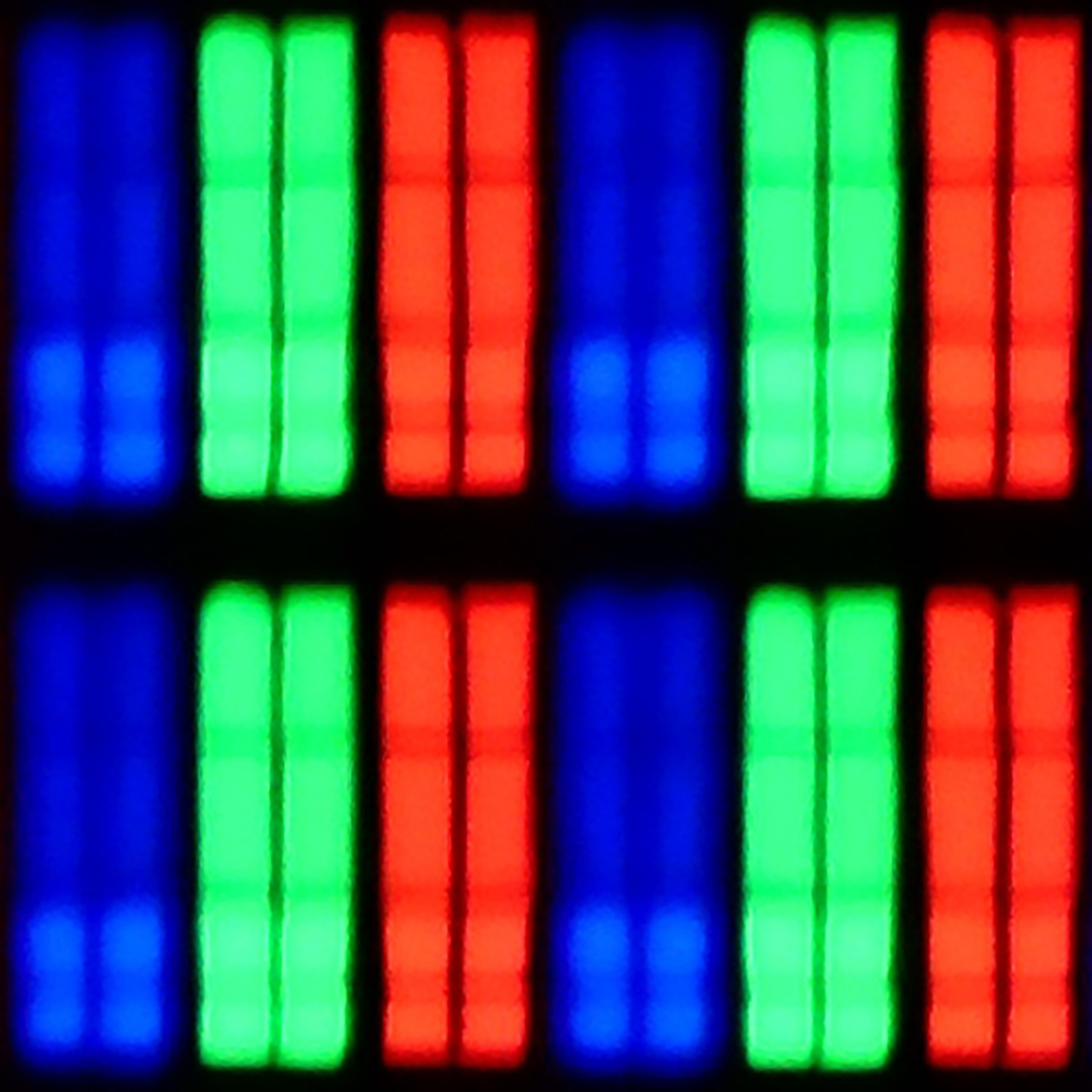
Panel uniformity:


Philips The One (PUS8959 / PUS8919 / PUS8909 / PUS8949
TCL C6K
TV features
6/10
7/10
- HDMI inputs0 x HDMI 2.0, 0 x HDMI 2.1 48Gbps2 x HDMI 2.0, 2 x HDMI 2.1 48Gbps
- OutputsToslink (Optical audio), eARC (HDMI), ARC (HDMI), Mini-Jack (Headphones)Toslink (Optical audio), eARC (HDMI), ARC (HDMI)
- Network InterfacesWi-Fi 2.4GHz, Wi-Fi 5GHz, Ethernet (LAN) 100MbpsWi-Fi 2.4GHz, Wi-Fi 5GHz, Ethernet (LAN) 100Mbps
- TV receptionDVB-T, DVB-T2, DVB-S, DVB-S2, DVB-CDVB-T, DVB-T2, DVB-S, DVB-S2, DVB-C
Classic features:
- Recording to USB (terrestrial TV)
- Recording programming
- Picture in Picture (PiP)
- RF remote control (no need to aim at the screen)
- Backlit remote control
- Teletext
- Audio only mode
- Possibility to connect Bluetooth headphones to the TV
- Possibility to simultaneously use Bluetooth headphones and the TV speaker
Smart features:
- AirPlay
- Screen mirroring (Windows Miracast)
- Wyszukiwanie głosowe
- Voice search in native language
- Ability to connect a keyboard and mouse



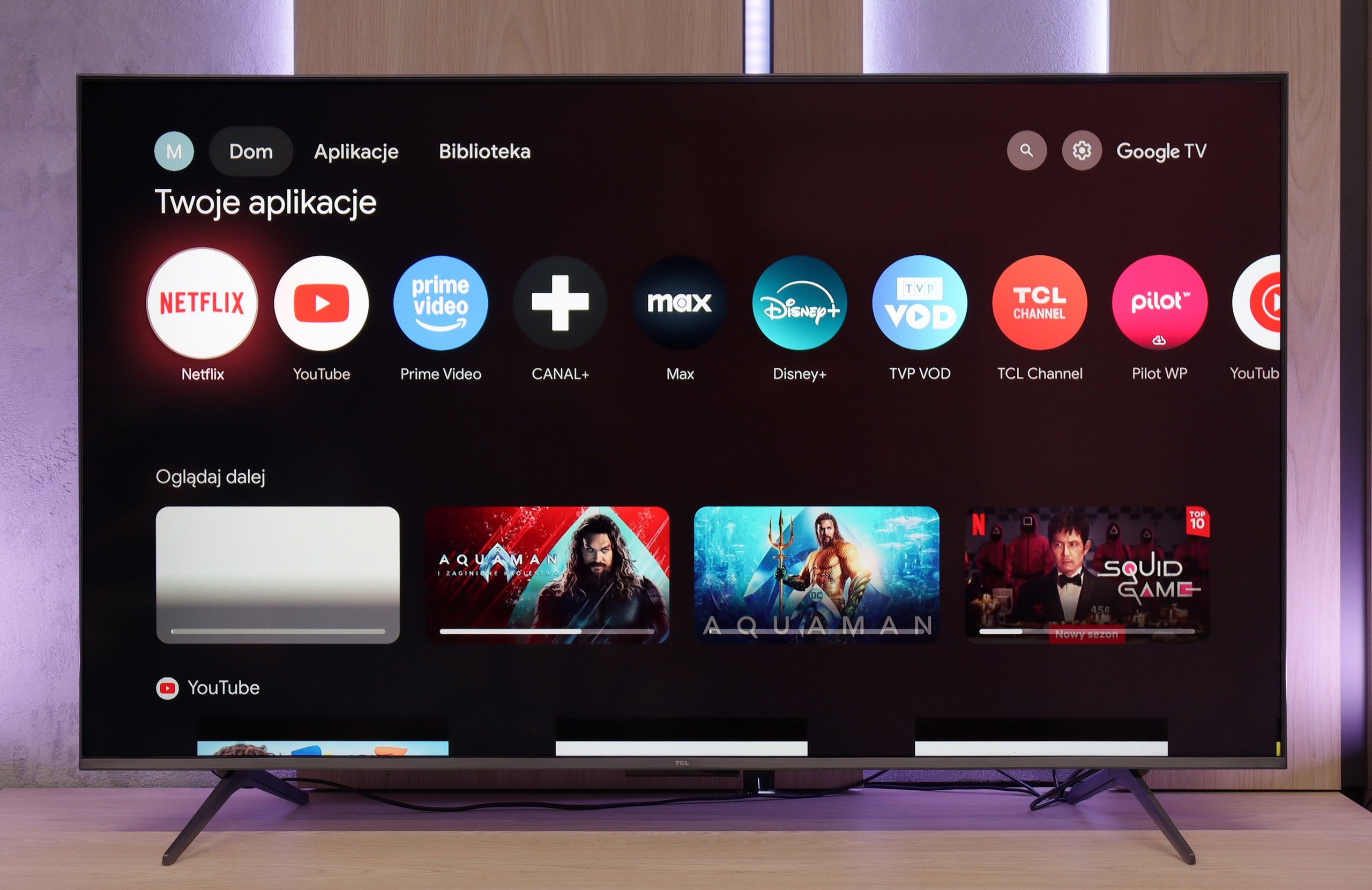
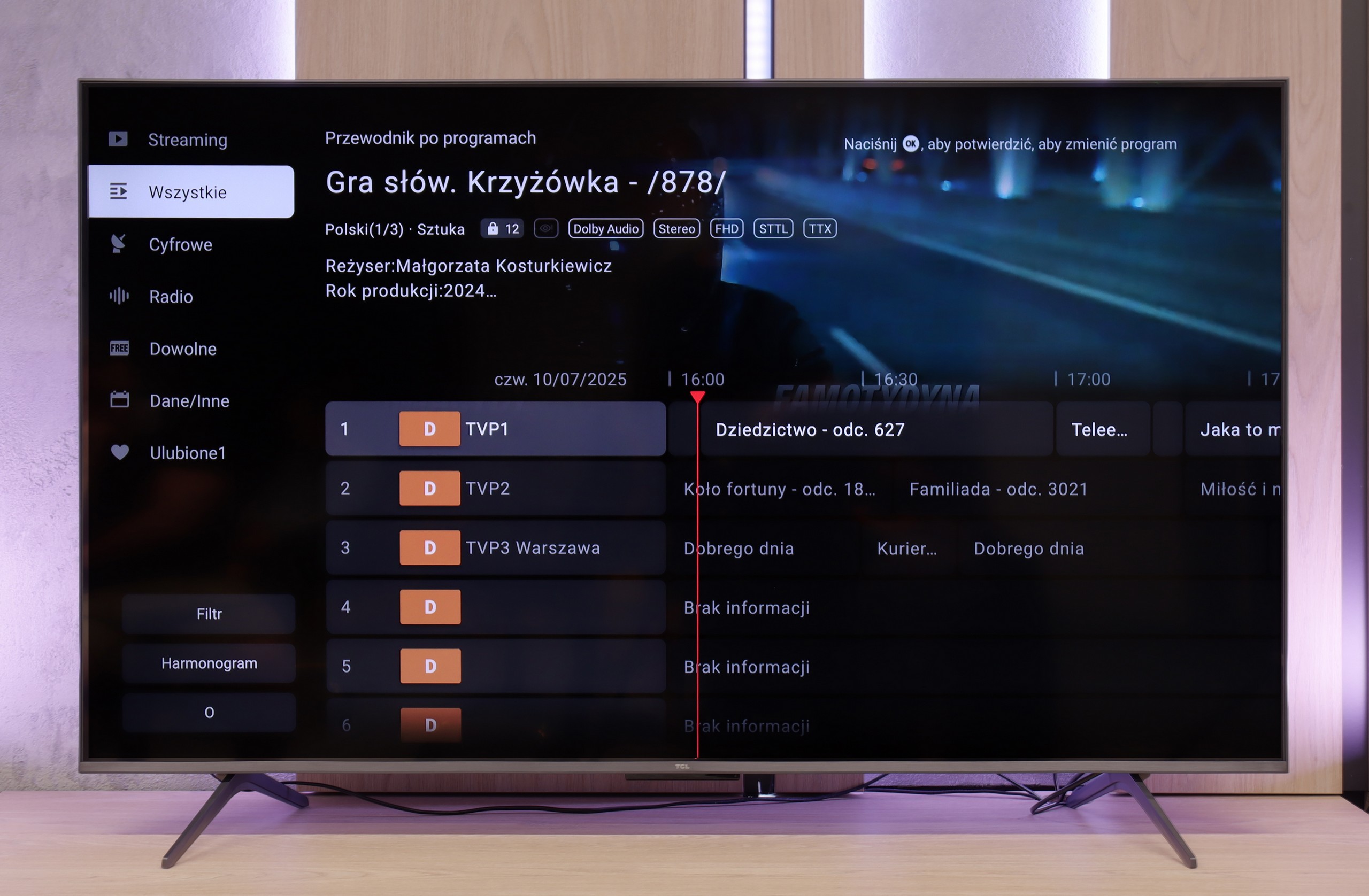
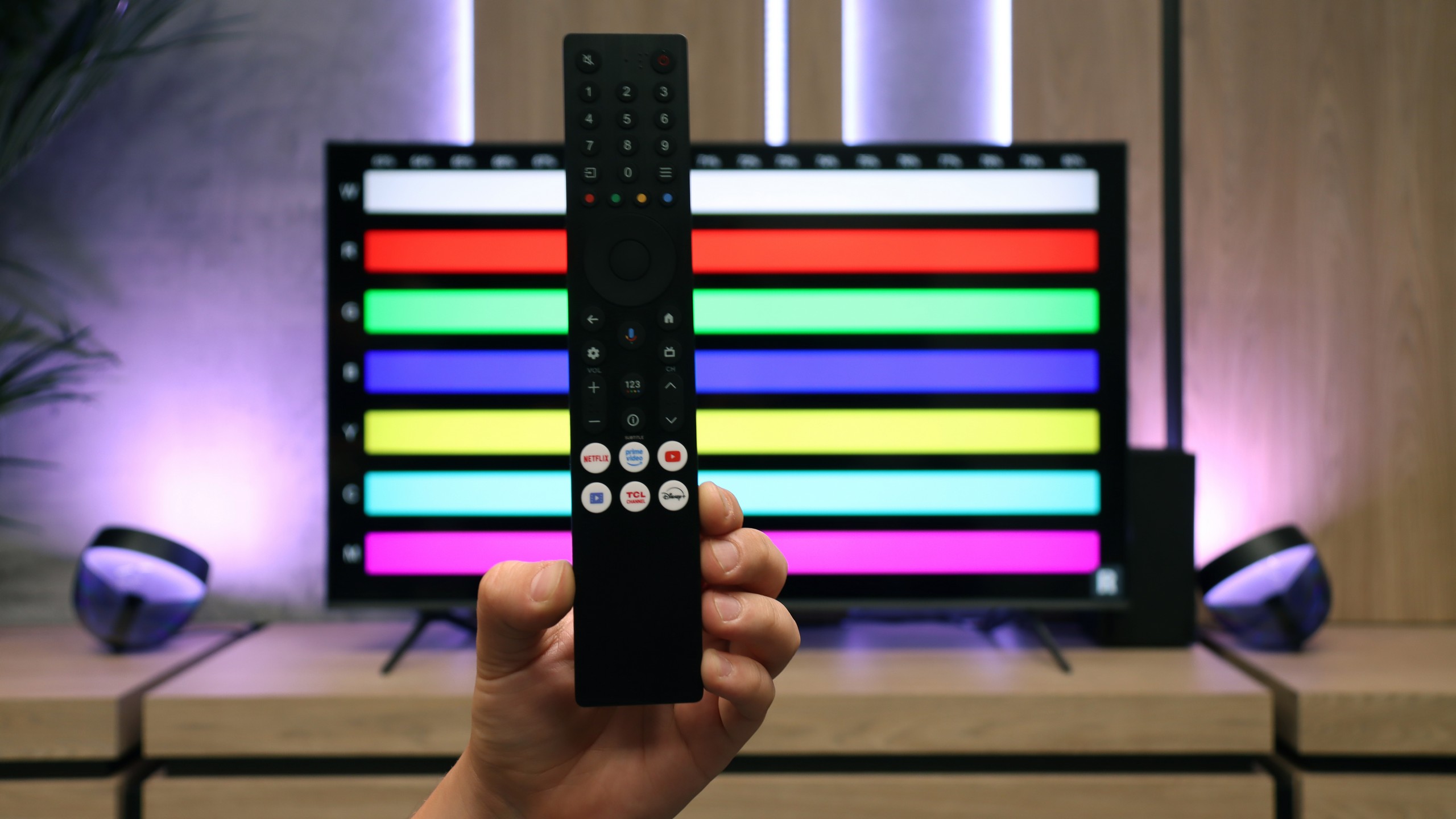
Philips PUS8959 is equipped with a three-sided Ambilight system – a flagship patent of this brand, which has been enjoyed by a dedicated group of fans for years. Ambilight is based on dynamic lighting of the wall behind the television, adapting to the content displayed on the screen, significantly enhancing the viewing experience, especially in a darkened room. This effect is unique and adds a certain kind of "magic" to watching, making many users choose Philips specifically for this feature.
When it comes to the operating system, Philips PUS8959 uses Titan OS – a system that is still in the early stages of development. There are visible growing pains, especially since Philips has moved away from Android in most of its models. Titan OS has a limited number of available applications. This is frustrating for those accustomed to a broader ecosystem like GoogleTV. Additionally, the television does not have AirPlay functionality, which limits its compatibility with Apple devices and may be a drawback for users looking for a flexible way to stream content.
The user features of Philips PUS8959 are a mix of pros and cons. The remote control that comes with the television is quite annoying – it requires aiming directly at the screen, which can be inconvenient. On the other hand, the voice function works without the need to aim, but it only supports English. On the plus side, the remote is backlit, making it easier to use in the dark. The television lacks PiP (Picture-in-Picture) functionality and the ability to record programs, which is a significant omission. However, the television is equipped with Bluetooth, allowing users to connect headphones or a keyboard, which can be useful – especially given the limited number of available applications, which may encourage the use of the built-in web browser.
Multimedia Features: Google TV
The standout feature of the TCL C6K is undoubtedly the Google TV system. It gives the television its character and gives it an edge over many competitors. We have a full suite of services – from support for popular streaming apps, through screen mirroring support, to AirPlay, so iPhone users will feel right at home. Additionally, there's Google Assistant (now in the Gemini AI version), which not only answers questions but also efficiently carries out simple commands like changing channels or searching for content on VOD services. The system itself operates quite responsively, although it’s hard not to mention a certain drawback – the clumsy translations in the Polish menu can elicit a smile but sometimes require a moment of thought to decipher what’s really meant.
Classic Features
When it comes to classic television features, the TCL C6K is rather average. We won’t find USB recording or PiP mode, which may be disappointing for some. However, the manufacturer hasn’t forgotten the basics – teletext television and a clear EPG are available, which still hold significance for some users. In everyday use, support for external audio devices via Bluetooth comes in handy – a straightforward way to connect a speaker or headphones, which could be a practical solution for seniors. Beyond that, it’s hard to spot elements that would distinguish the C6K from its competitors – it’s simply a solid, but standard package of basic features.
Playing files from USB
8.2/10
8.9/10
Supported photo formats:
Maximum photo resolution:

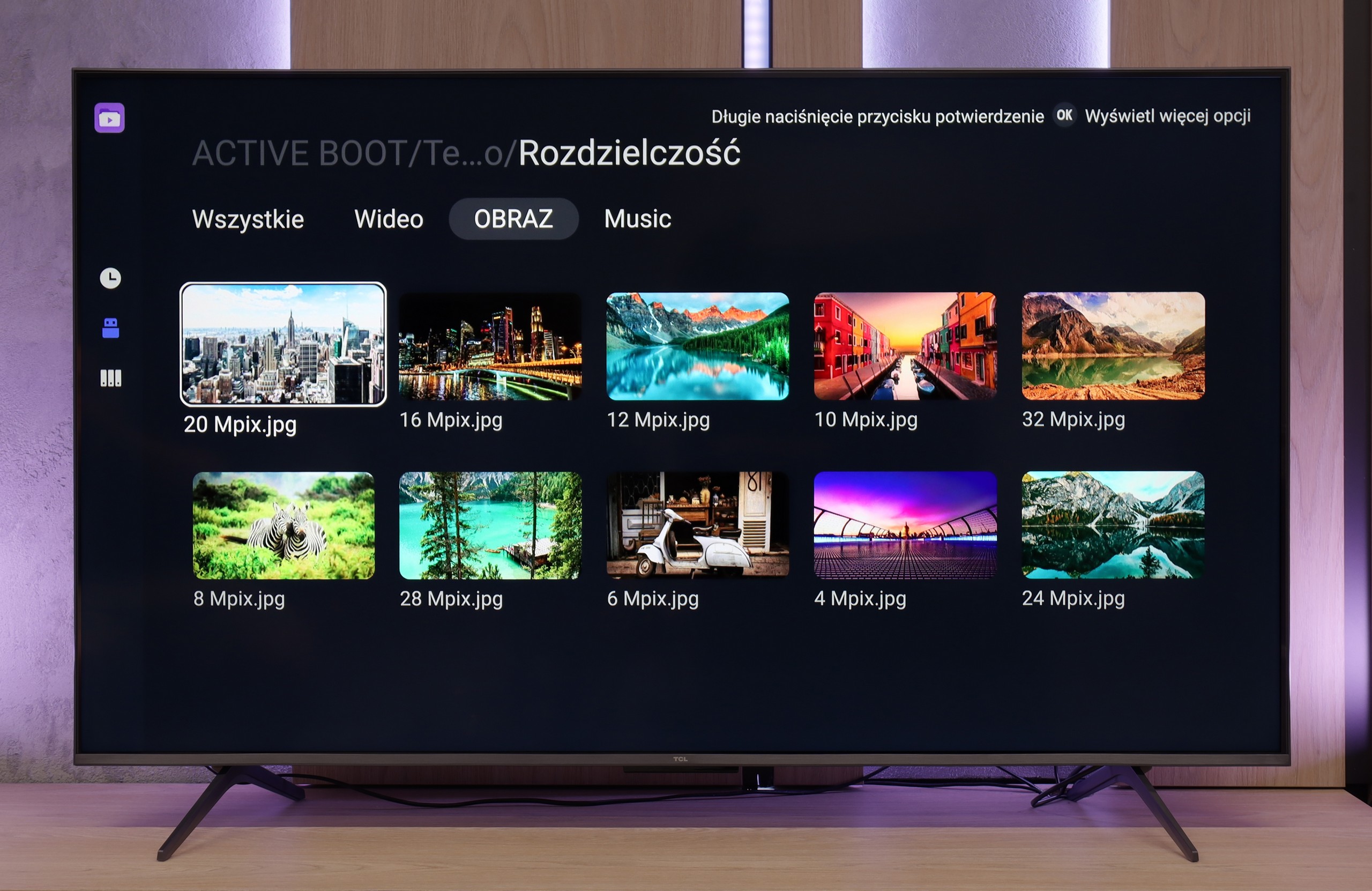
Although the Titan OS system on the Philips PUS8959 TV is still in its early stages, it deserves praise for supporting Polish subtitles embedded in films, which is a significant convenience for users dealing with external files. If we want to play a film from a connected USB device, the TV will do this without any major issues, providing a comfortable viewing experience without the need for additional subtitle configuration.
As for photos, the TV should have no major difficulties playing them. It supports most popular formats, although there is a lack of support for less common standards, such as HEIC used in Apple devices. This means that some photos, especially from newer Apple devices, may require prior conversion to a more standard format in order to be played on the Philips screen.
The built-in media player in the TCL C6K performs really well – practically all popular file formats work without major issues. There are minor exceptions, particularly with less common codecs or unusual video file configurations, but in everyday use, this rarely becomes noticeable. The biggest plus, however, is that the television runs on Google TV, which offers complete freedom in choosing additional software. If someone encounters a file that the standard player can't handle, all they need to do is install an alternative – like VLC – and the problem disappears.
Apps
6.2/10
9.6/10














































Sound
6.4/10
6.5/10
- Subjective sound quality:6.4/106.5/10
- Dolby Digital Plus 7.1:
- Dolby True HD 7.1:
- Dolby Atmos in Dolby Digital Plus (JOC):
- Dolby Atmos in Dolby True HD:
- DTS:X in DTS-HD MA:
- DTS-HD Master Audio:
The sound on the Philips PUS8959 unfortunately leaves a lot to be desired. While you can hear low frequencies in the playback, the bass is very weak, which results in overall unsatisfactory sound quality. The television performs averagely, especially when compared to more advanced sound systems available on the market.
Despite the average quality of the speakers, the television supports all essential audio codecs, which may please users utilizing external home theatre systems. Thanks to compatibility with various audio formats, the Philips PUS8959 can offer a good audio experience when connected to the right external speakers or amplifier, providing a fuller, more cinematic sound.
In terms of audio, the TCL C6K performs quite well. The manufacturer has been boasting about its collaboration with the Onkyo brand for several years, and it indeed reflects on the sound quality. The sound is pleasant, with clear mid-tones and fairly crisp highs, and overall, it gives the impression of being well-balanced. Of course, it won't replace a proper soundbar, especially regarding bass depth, but for built-in speakers in a TV from this price segment – it’s really quite good.


